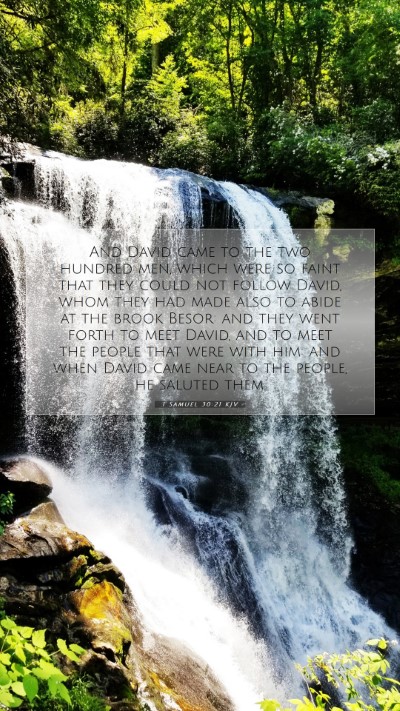Bible Verse Meaning: 1 Samuel 30:21
Verse Text: "And David came to the two hundred men, which were so faint that they could not follow David, whom they had made also to abide at the brook Besor; and they went forth to meet David, and to meet the people that were with him: and when David came near to the people, he saluted them."
Summary of Insights from Commentaries
This verse highlights a significant moment in David's leadership and the principles of compassion and reward within a community. Below, we present a combined interpretation based on public domain commentaries.
Leadership and Compassion
Matthew Henry emphasizes David's compassionate leadership. Despite the strenuous journey and conflict they faced, David returned to those who were too weary to continue. He makes an important decision to ensure that none of his men are left behind, demonstrating a key quality of good leadership: care for all members, not just the strongest.
Recognition of Labor
Albert Barnes notes that David's return to the two hundred men left behind at the brook signifies the importance of recognizing the efforts of all individuals within a community. Each member's contribution, regardless of their physical state, is acknowledged and valued, reinforcing the idea that everyone plays a role in the success of the group.
Encouragement and Brotherhood
Adam Clarke interprets this moment as one of encouragement and fellowship. The meeting between David and the anxious men serves to strengthen their bonds and morale. When David greeted them, it was not just a formality; it was an affirmation of their importance and collective identity as a people united in purpose.
Application in Daily Life
This verse can serve as a guide for various settings, including Bible study groups or online Bible study sessions. The implications of caring for others, recognizing contributions, and fostering community are central themes that can enrich discussions and personal applications.
Commentary and Exegesis
The exegesis of this passage leads us to consider how we interpret our roles in our personal circles, workplaces, and communities. It challenges readers to reflect on their leadership styles and the extent to which they embody compassion and recognition.
Key Points for Understanding:
- Leadership requires empathy and consideration: David’s action illustrates great leadership qualities.
- The significance of every individual's role: There should be no hierarchy in value within a community.
- Fellowship strengthens community: Mutual respect and recognition foster unity and motivation.
Cross References
- Exodus 17:12-13: Moses’ established leadership with support from Aaron and Hur.
- Luke 15:20: The father’s welcoming attitude towards the prodigal son, reflecting compassion.
- Philippians 2:4: Paul’s exhortation to look out for the interests of others.
Conclusion
This verse encapsulates the essence of community, leadership, and compassion. Understanding this scripture deepens our appreciation for interpersonal relationships and guides us in our leadership practices, whether in familial, social, or spiritual contexts. In essence, reflecting on the meaning of this Bible verse can inspire leaders and members alike to uphold the values of empathy, recognition, and community solidarity.
Further Study
For those looking to delve deeper into the understanding and applications of Bible verse meanings and Bible verse interpretations, consider exploring:
- How to interpret Bible verses through historical context.
- Understanding difficult Bible passages for better clarity.
- Applying Bible verses to daily life and its challenges.


